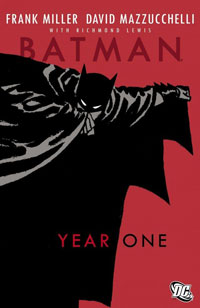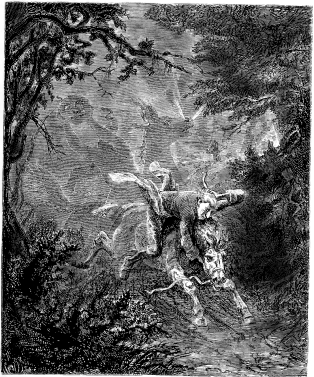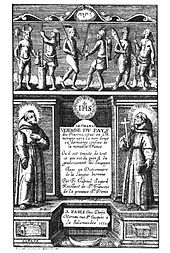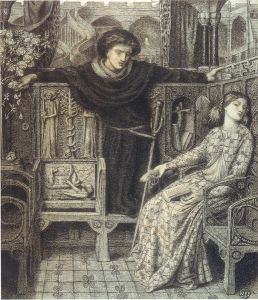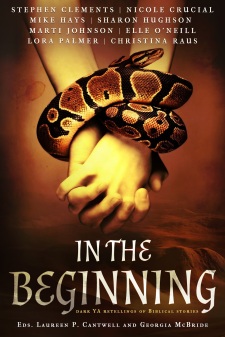I read The Legend of Sleepy Hollow at least once a year, preferably in the month of October when the winds turn chill and the leaves fall and swirl in our path. There have been cartoons, movies and shortened version of this story that are very entertaining in their own right, but none compare to the original bestowed upon us by Washington Irving. In a day of age where we rush and run and squeeze activity after activity into our lives, it’s a fine thing to be able to turn to Irving and disappear into his stories and settings. His descriptions, which may be considered verbose by today’s standards, transport the reader back into another space and time. In The Legend of Sleepy Hollow, he does this masterfully. I always feel like I’m walking down a Hudson Valley path listening to the narrator tell this tale while he points out the Van Tassel home, the schoolhouse, the churchyard, and the wooden bridge.
Here is the opening of the story in all its glory. I hope it entices you to have a read or reread of the whole tale this week in the spirit of the roaming spirits of the season. You can find the eBook file here to download.
Have a safe and happy Halloween!
The Legend of Sleepy Hollow by Washington Irving
In the bosom of one of those spacious coves which indent the eastern
shore of the Hudson, at that broad expansion of the river denominated by
the ancient Dutch navigators the Tappan Zee, and where they always
prudently shortened sail and implored the protection of St. Nicholas when they crossed, there lies a small market town or rural port, which by
some is called Greensburgh, but which is more generally and properly
known by the name of Tarry Town. This name was given, we are told, in
former days, by the good housewives of the adjacent country, from the
inveterate propensity of their husbands to linger about the village tavern
on market days. Be that as it may, I do not vouch for the fact, but merely
advert to it, for the sake of being precise and authentic. Not far from this
village, perhaps about two miles, there is a little valley or rather lap of
land among high hills, which is one of the quietest places in the whole
world. A small brook glides through it, with just murmur enough to lull
one to repose; and the occasional whistle of a quail or tapping of a
woodpecker is almost the only sound that ever breaks in upon the
uniform tranquillity.
I recollect that, when a stripling, my first exploit in squirrel-shooting was
in a grove of tall walnut-trees that shades one side of the valley. I had
wandered into it at noontime, when all nature is peculiarly quiet, and
was startled by the roar of my own gun, as it broke the Sabbath stillness
around and was prolonged and reverberated by the angry echoes. If ever
I should wish for a retreat whither I might steal from the world and its
distractions, and dream quietly away the remnant of a troubled life, I
know of none more promising than this little valley.
From the listless repose of the place, and the peculiar character of its
inhabitants, who are descendants from the original Dutch settlers, this
sequestered glen has long been known by the name of Sleepy Hollow,
and its rustic lads are called the Sleepy Hollow Boys throughout all the
neighboring country. A drowsy, dreamy influence seems to hang over the
land, and to pervade the very atmosphere. Some say that the place was
bewitched by a High German doctor, during the early days of the
settlement; others, that an old Indian chief, the prophet or wizard of his
tribe, held his powwows there before the country was discovered by
Master Hendrick Hudson. Certain it is, the place still continues under the
sway of some witching power, that holds a spell over the minds of the
good people, causing them to walk in a continual reverie. They are given
to all kinds of marvellous beliefs, are subject to trances and visions, and
frequently see strange sights, and hear music and voices in the air. The
whole neighborhood abounds with local tales, haunted spots, and
twilight superstitions; stars shoot and meteors glare oftener across the
valley than in any other part of the country, and the nightmare, with her
whole ninefold, seems to make it the favorite scene of her gambols.
The dominant spirit, however, that haunts this enchanted region, and
seems to be commander-in-chief of all the powers of the air, is the
apparition of a figure on horseback, without a head. It is said by some to
be the ghost of a Hessian trooper, whose head had been carried away by
a cannon-ball, in some nameless battle during the Revolutionary War,
and who is ever and anon seen by the country folk hurrying along in the
gloom of night, as if on the wings of the wind. His haunts are not
confined to the valley, but extend at times to the adjacent roads, and
especially to the vicinity of a church at no great distance. Indeed, certain
of the most authentic historians of those parts, who have been careful in
collecting and collating the floating facts concerning this spectre, allege
that the body of the trooper having been buried in the churchyard, the
ghost rides forth to the scene of battle in nightly quest of his head, and
that the rushing speed with which he sometimes passes along the
Hollow, like a midnight blast, is owing to his being belated, and in a
hurry to get back to the churchyard before daybreak.
Such is the general purport of this legendary superstition, which has
furnished materials for many a wild story in that region of shadows; and
the spectre is known at all the country firesides, by the name of the
Headless Horseman of Sleepy Hollow.

